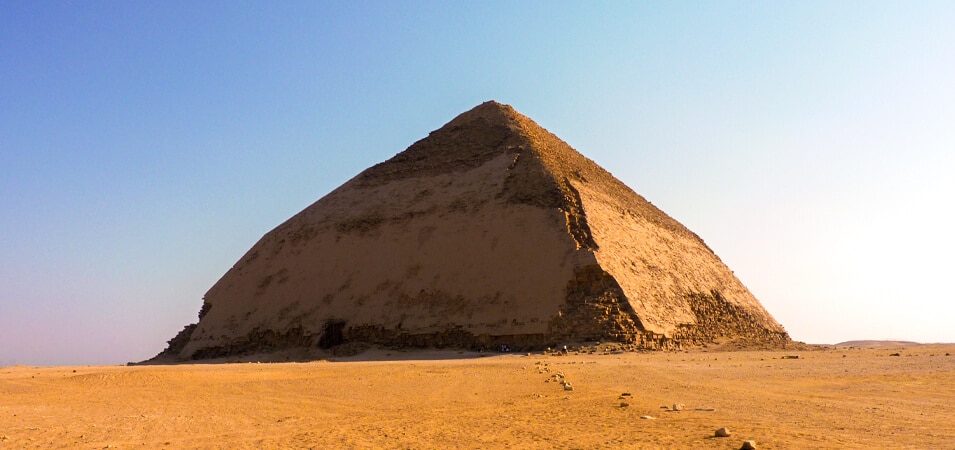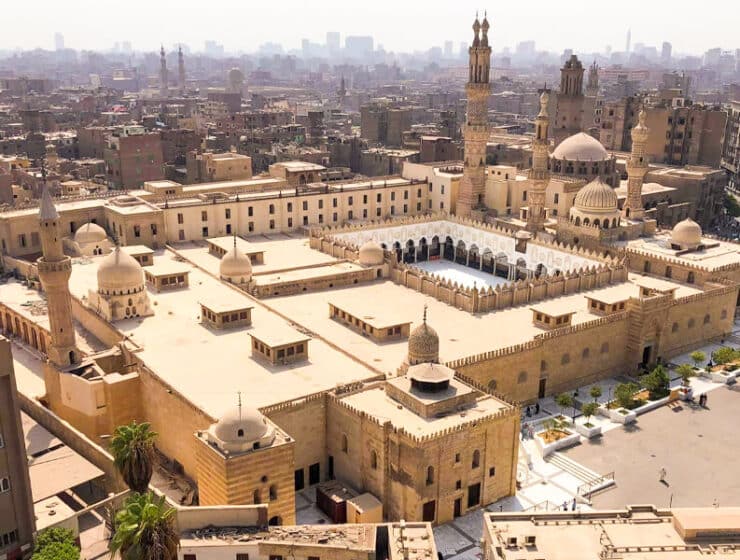The Pyramids of Dahshur are timeless monuments to ancient Egypt’s rich history and architectural prowess. Nestled in the desert sands, these pyramids are a testament to the ingenuity and vision of the Egyptian civilization. Unlike their more famous counterparts at Giza, the pyramids at Dahshur have a unique charm and charisma, waiting to be explored by travelers and history enthusiasts alike. In this blog, we will delve into the fascinating world of Dahshur’s pyramids, uncovering their history, architectural wonders, and the legends that shroud them in mystery. Join us on this journey through time as we unravel the enduring legacy of the Pyramids of Dahshur.
Explore the ancient Saqqara Necropolis of Cairo, home to the Step Pyramid.
History of Dahshur Necropolis
The history of Dahshur Necropolis is a captivating tale of ancient Egyptian civilization that predates the well-known pyramids of Giza. This sacred burial site, located on the west bank of the Nile River, holds the remains of pharaohs and nobility from the Old Kingdom period. Dahshur’s significance in Egyptian history is underscored by its role as a precursor to the development of pyramid construction techniques. The cemetery is home to a series of pyramids and tombs that reveal Egypt’s evolving architectural and cultural aspects during that era. As we delve into the history of Dahshur Necropolis, we’ll unveil the dynasties that contributed to its creation, explore the purpose behind these grand structures, and gain a deeper appreciation for this remarkable chapter in the annals of ancient history.
Experience A Day in the Ancient City of Luxor.
Architectural features of the Pyramids of Dahshur

The Pyramids of Dahshur boast unique architectural features that distinguish them from other ancient Egyptian pyramids. These remarkable structures offer a glimpse into the old builders’ innovative techniques and design choices. One of the standout features is the Bent Pyramid, which earned its name due to its unusual change in angle midway up the structure. The Red Pyramid, known for its reddish hue and impressive symmetry, showcases the mastery of ancient engineering. Additionally, the lesser-known Pyramid of Amenemhat III reveals intriguing aspects of architectural evolution during the Middle Kingdom. In this section, we will delve deep into the architectural marvels of these pyramids, discussing their shapes, materials, interior chambers, and the symbolism integral to their design. Join us on this exploration of the Pyramids of Dahshur’s architectural wonders.
Immerse yourself in the enchanting allure of Cairo by Night.
The Bent Pyramid – a unique architectural marvel
The Bent Pyramid, one of the Pyramids of Dahshur, stands as a testament to the audacity and innovation of ancient Egyptian architects. What sets this pyramid apart is its distinctively unusual shape – it starts with a steep angle and then changes to a shallower angle, giving it the appearance of being “bent.” This architectural anomaly has puzzled scholars and historians for centuries, raising questions about the reasons behind this design choice. Some speculate that it might have been a response to engineering challenges or an attempt to prevent structural instability. Others suggest symbolic or religious significance. In exploring the Bent Pyramid, we will unravel the mysteries surrounding its construction, delve into the theories proposed by experts, and appreciate the awe-inspiring craftsmanship that went into creating this unique architectural marvel.
Marvel at the Pyramid of Djoser, one of the oldest pyramids.
The Red Pyramid – a symbol of ancient Egyptian power

The Red Pyramid, nestled within the Dahshur Necropolis, stands as a remarkable architectural feat and a symbol of ancient Egypt’s enduring power and authority. Named for the reddish hue of its limestone blocks, this pyramid was built during the reign of Pharaoh Sneferu, marking a pivotal moment in the evolution of pyramid construction techniques. Its towering symmetry and imposing presence in the desert landscape serve as a testament to the might and prestige of Egypt during that era. The Red Pyramid has long been regarded as an essential representation of royal authority and the divine connection between the pharaohs and the afterlife. In this section, we will delve into the historical and cultural significance of the Red Pyramid, shedding light on its role as a symbol of ancient Egyptian power and sovereignty.
Please make the most of your Cairo Layover Tours with our exclusive tours.
The Pyramid of Amenemhat III – a lesser-known gem
Amidst the grandeur of the Pyramids of Dahshur lies a lesser-known gem, the Pyramid of Amenemhat III, often overshadowed by its more renowned counterparts in Egypt. Built during the reign of Pharaoh Amenemhat III of the Middle Kingdom, this pyramid is a testament to the artistry and engineering prowess of the ancient Egyptians. While it may not be as colossal as the Great Pyramid of Giza, its modest size carries a charm of its own. This pyramid showcases the evolving architectural techniques and design principles of its time, offering valuable insights into the history and culture of the Middle Kingdom period. In this segment, we will spotlight the Pyramid of Amenemhat III, unveiling its unique features, historical context, and the mysteries surrounding this hidden gem within Dahshur’s necropolis.
Discover the historical beauty of the Qalawun Complex, a masterpiece.
The mysteries and legends surrounding the Pyramids of Dahshur
The Pyramids of Dahshur, like all ancient wonders, are shrouded in mysteries and legends that have endured through the ages. These enigmatic structures have captivated the imagination for millennia, sparking tales of hidden treasures, curses, and supernatural occurrences. Stories of curses unleashed upon tomb raiders and tales of lost pharaohs’ riches continue to intrigue and mystify. From the whispered secrets of the builders’ techniques to the unexplained phenomena reported by visitors, the Pyramids of Dahshur have been a source of fascination and speculation. In this section, we will journey into these enduring mysteries and legends, exploring the myths and realities surrounding these iconic Egyptian monuments and uncovering the mystique that keeps us drawn to their allure.
Exploring the Pyramids of Dahshur – visitor information and tips
For those eager to explore the Pyramids of Dahshur, it’s essential to be well-prepared to make the most of this awe-inspiring journey through history. To facilitate your visit, planning and gathering relevant information is advisable. Start by checking the opening hours and admission fees of the site. Remember to wear comfortable clothing and sturdy footwear, as exploring the desert terrain can be physically demanding. Guided tours are often available, providing valuable insights into the history and significance of these pyramids. Be sure to carry essentials like water, sunscreen, and a hat to protect yourself from the sun’s intense rays. Respecting the historical site by refraining from touching or climbing the pyramids is crucial to preserving these ancient treasures for future generations. This section will provide visitor information and essential tips to ensure a memorable and respectful experience while exploring the Pyramids of Dahshur.
Other attractions near the Pyramids of Dahshur

While the Pyramids of Dahshur are undeniably the stars of the show, the surrounding area offers a wealth of other attractions that add depth to your journey through ancient Egypt. Just a stone’s throw away, you’ll find the famous pyramids of Giza, including the Great Pyramid and the Sphinx, which are must-visit sites for any traveler interested in Egyptology. The Saqqara Necropolis, renowned for its Step Pyramid, is also within reach and showcases the evolution of pyramid construction. Take advantage of the Egyptian Museum in Cairo, home to a vast collection of ancient artifacts, mummies, and treasures from Egypt’s history. If you’re a fan of Islamic architecture, consider exploring the historic mosques and bustling markets of Cairo. This section will overview these nearby attractions, enhancing your Egyptian adventure beyond the Pyramids of Dahshur.
Visit the iconic Salah El-Din Citadel and its impressive medieval architecture.
How to get to the Pyramids of Dahshur
Getting to the Pyramids of Dahshur is an exciting part of the journey. If you’re based in Cairo, the most convenient way to reach Dahshur is by car or taxi. The pyramids are approximately 40 kilometers (about 25 miles) south of Cairo, and the drive typically takes 45 minutes to an hour, depending on traffic.
Alternatively, you can opt for a guided tour with transportation to and from the pyramids. Many tour operators in Cairo offer day trips that include visits to Dahshur, Saqqara, and the Pyramids of Giza.
For those seeking a more adventurous experience, consider taking a public bus from Cairo to Dahshur. Buses depart from various locations in Cairo and can be affordable, but checking schedules and routes in advance is important.
Lastly, if you’re staying at a hotel in the area, they may offer transportation services or assistance in arranging a visit to the Pyramids of Dahshur.
In this section, we’ll provide detailed instructions on how to get to the Pyramids of Dahshur, ensuring a smooth and enjoyable journey to this historical site.
Explore our Tours:
- Day Tour to Giza Pyramids, Memphis, Dahshur and Saqqara
- Day Tour to Memphis and Saqqara and Dahshur
- Half Day Tour To Dahshur And Sakkara
- Day Tour to Giza Pyramids and Egyptian Museum and Citadel
- Day Tour to Giza Pyramids and Egyptian Museum and Khan Al Khalili
- Day Tour to Giza Pyramids and Egyptian Museum Of Civilization
- Giza Pyramids Sound and Light Show
- Half Day Tour To Giza Pyramids and Sphinx
Conclusion – The enduring legacy of the Pyramids of Dahshur
In judgment, the Pyramids of Dahshur are remarkable testaments to ancient Egypt’s ingenuity, history, and enduring legacy. These lesser-known treasures offer a unique perspective on the evolution of pyramid construction, architectural innovation, and the profound symbolism defining civilization.
From the enigmatic Bent Pyramid to the grandeur of the Red Pyramid and the hidden gem of the Pyramid of Amenemhat III, each structure tells a compelling story of a bygone era. The mysteries and legends surrounding these pyramids continue to intrigue and inspire, adding layers of mystique to their ancient stones.
For modern-day travelers, exploring the Pyramids of Dahshur is a journey through time, a chance to witness the enduring power of human creativity and engineering. The nearby attractions further enrich the experience, connecting Dahshur to the broader tapestry of Egypt’s historical wonders.
As we walk in the footsteps of pharaohs and gaze upon these awe-inspiring monuments, we honor the past and acknowledge the enduring legacy that continues to captivate and inspire generations worldwide. The Pyramids of Dahshur are silent witnesses to the timeless spirit of human achievement and the enduring allure of ancient Egypt.





